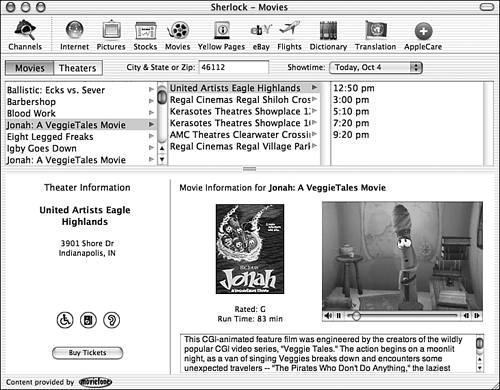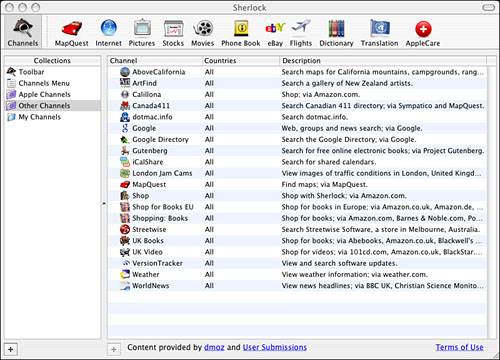Using Sherlock to Search the Web
The Mac's Web searching application, called Sherlock, can help you search for various types of content from various providers on the Web. Sherlock is very powerful and enables you to find certain kinds of information on the Web quickly and easily.
Sherlock uses channels to categorize the information you search for. When you use a channel, the tools you search with are specific to that channel. For example, one of Sherlock's included channels is the Movies channel, which enables you to search for movie information in your area (see Figure 13.13). To use a channel, click its button on the Sherlock toolbar.
Figure 13.13. Sherlock's Movies channel enables you to locate information and show times for movies you are interested in; you can even view the trailer in the Sherlock window!

When you select a channel, such as the Internet channel that you can use for general Web searches, Sherlock's window provides a set of tools you can use to perform your Web content search (see Figure 13.14).
Figure 13.14. Sherlock provides a powerful set of tools you can use to find all sorts of information on the Web.

By default, Sherlock includes a number of Apple-supplied channels, which you see on the Sherlock toolbar. These include the following:
Internet? Use this channel for your general Internet searches.
Pictures? With this channel, you can find images related to specific topics.
Stocks? Use this channel to track your favorite stocks.
Movies? This is one of the coolest channels. You can use it to find show times and location information for movies you are interested in. You can also view a movie's trailer in the Sherlock window.
Yellow Pages? Use this channel to find addresses, phone numbers, and even driving directions for businesses.
eBay? If you are an eBay fan, this channel is for you.
Flights? This enables you to find flight information and purchase tickets.
Dictionary? Use this channel to find correct spellings of specific words or synonyms.
Translation? This channel enables you to translate words and phrases among various languages.
AppleCare? Use this channel to search for information from Apple, such as to get help with problems you are having.
NOTE
Each Sherlock channel is provided by one or more content providers. When you select a channel, its providers are shown at the bottom of the Sherlock window.
There are also a number of other channels you can use; these are visible when you click the Channels button on the toolbar and select the collection of channels in which you are interested (see Figure 13.15). For each channel, you see its name and icon, the countries in which it can be used, and a description.
Figure 13.15. When you select the Other Channels collection, you see a large number of other channels you can use to search the Web.

NOTE
The channels in the Other Channels collection are provided by third-party companies. The first time you select the Other Channels collection, you see a prompt informing you about this.
You can organize the channels in Sherlock using tools similar to those you use in other locations. For example, to add a channel to the Sherlock toolbar, drag it from the list of channels onto the toolbar (for example, in Figure 13.15, you can see that I placed the MapQuest channel on my toolbar). You can also add channels to and access them from the Channel menu; to add them there, simply place the channel in the Channels Menu collection.
NOTE
Sherlock channels use cookies to store information about you. If you don't want cookies to be used, open the Sherlock Preferences and click the Never radio button.
Performing Searches with Sherlock
Now you that you understand the basics of Sherlock, you can use it to search:
Open Sherlock.
Click the channel you want to use for your search. The Sherlock window is updated to reflect the channel you selected (see Figure 13.16). Each channel has its own search tools, but they are all simple to use.
Figure 13.16. Don't know how to spell "menagerie"? I didn't either, but with Sherlock, it doesn't take long to find out.

In the Search box at the top of the window, type the text you want to search for. You can enter individual words or phrases in the Search box. The more information you enter, the more specific your search will be.
Configure the channel's other tools. For example, when you search the Movies channel, you select Movies to search by movie, or Theaters to search by theater; then enter your ZIP Code and select the date you want information for.
Click the Search button. If you aren't already connected to the Internet, your Mac connects itself. Then, Sherlock moves onto the Net and performs your search. The results of your search appear in the Results area.
Browse through the results of your search; when you find a site that looks interesting, double-click it. If the result is a Web site, it opens in your default Web browser.
TIP
You can show or hide the toolbar by clicking the Show/Hide toolbar button; selecting View, Show/Hide Toolbar; or pressing Option-![]() -T.
-T.
The Sherlock Results pane looks quite different depending on the channel you are using. When you use the Internet channel, the results are Web sites that meet your search criteria. When you use the Pictures channel, the results are individual images. Although the channels provide different types of results, they are all easy to work with, and after you've used one channel, you won't have any trouble using the others.
In some channels, such as the AppleCare channel, the content that Sherlock finds appears in the lower pane of the window. You can view such content directly in the Sherlock window.
TIP
You can change the relative sizes of the panes in the Sherlock window by dragging the resize handle located in the center of the separating bar.
Customizing the Sherlock Toolbar
You can customize the Sherlock toolbar just as you can the toolbar in Finder windows:
Open Sherlock.
Select View, Customize Toolbar. The Customize toolbar sheet appears.
Drag channels off the toolbar to remove them. (You can add them again by dragging them back onto the toolbar.)
Drag the space, flexible space, and separator icons onto the toolbar to organize it.
Drag channel icons around on the toolbar to rearrange them.
Use the Show pop-up menu to select how you want the toolbar to look, such as including both icons and text or text only.
Check the Use Small Size check box to use small icons on the toolbar.
Click Done.
TIP
You can restore the default Sherlock toolbar by dragging the default set onto the toolbar.
Adding Other Sherlock Channels
The default installation of Sherlock includes a number of Apple and third-party channels, but you can also add your own using the following general steps:
Locate the channel you want to add, such as by visiting a Web site.
Download the channel.
Select Channel, Add Channel.
Select the channel you want to add.
TIP
You can create shortcuts to channels so you can open a channel from the Finder by opening its shortcut. To do so, select the channel for which you want to create a short-cut. Then select Channel, Make a Shortcut (![]() -L). In the resulting sheet, name the shortcut, select a location, and click Make. When you want to use that channel, open its shortcut. A new Sherlock window opens and the channel is ready for your search.
-L). In the resulting sheet, name the shortcut, select a location, and click Make. When you want to use that channel, open its shortcut. A new Sherlock window opens and the channel is ready for your search.







